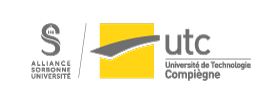Operative science and semiotic engineering : from graphic machines to organic morphogenesis
Science opérative et ingénierie sémiotique : des machines graphiques à la morphogenèse organique
Résumé
This study is divided into three parts: the first is problematic, the second is analytical and the third is programmatic. The first part presents the theoretical framework of semiotic engineering, its problematic, its heritage and its articulation with the problematic of diagrammatic representations. A historical and genetic analysis of operative thought, leading to algorithmic representation, forces us to acknowledge that diagrammatic representation is irreducible to algorithmic representation. For this reason, the diagrammatic representation is the bearer of an additional intelligibility of a semiotic order that needs to be characterised. This is what we try to do in the second part of this work, by proposing analyses of diagrams in different fields of knowledge, whether theoretical or applied. In fact, our aim is to propose a methodology of artificial intelligence that is characterized by the forgetting of the logicist and formalist position, namely the symbolic, effective and yet non-computational character of diagrammatic representations. The semiotic engineering of diagrammatic systems, as we call the artificial intelligence conceived and realised in this framework, is dedicated to the identification of visual means of elaborating theoretical and practical knowledge with the help of diagrammatic representations. For the diagrammatic system constructed must produce a meaning in the practical domain that is recognised by those who read it and use it as a tool for solving problems that cannot be solved algorithmically. This is why we argue that diagrams are semiotic machines. By articulating a theory of the material inscription of knowledge (B. Bachimont's theory of support) with the theory of individuation processes (which comes from G. Simondon) thanks to diagrammatic semiotics (which comes from C. S. Peirce), we aim to support two complementary theses: on the one hand, that diagrammatic inscription corresponds to the recording of operative knowledge (thesis 1); on the other hand, that operative knowledge corresponds to the analogical intuition and actualisation of the diagrammatic inscription (thesis 2). The second thesis, which is the reciprocal of the first, presupposes the rehabilitation of analogy as a method of invention. By reinscribing diagrams in a long history of technique, we show in a third and final part that they open a new chapter in the history of writing, appearing as intellectual technologies constituting new ways of thinking and of equipping thought. Likewise, by reinscribing analogical reasoning in a long history of science and technology, we argue for the rehabilitation of the method of analogical reasoning as a rational and valid approach, as long as it is exercised under certain conditions and within certain limits. Finally, by arguing for the thesis that the diagram is a semiotechnical device at the heart of the living, wehypothesise that it is a relevant tool for understanding the processes of morphogenesis within theframework of a philosophy of nature.
Cette étude comprend trois parties : la première est problématique, la seconde est analytique, la troisième est programmatique. La première partie présente le cadre théorique de l’ingénierie sémiotique, sa problématique, son héritage et son articulation à la problématique des représentations diagrammatiques. Une analyse historique et génétique de la pensée opératoire, conduisant à la représentation algorithmique, nous contraint à devoir reconnaître que la représentation diagrammatique est irréductible à la représentation algorithmique. Pour cette raison, la représentation diagrammatique est porteuse d’un supplément d’intelligibilité d’ordre sémiotique qu’il faut caractériser.C’est ce à quoi nous nous attelons dans la deuxième partie de ce travail, en proposant des analyses de diagrammes dans divers champs du savoir, qu’ils soient théoriques ou appliqués. Notre propos est en effet de proposer une méthodologie de l’intelligence artificielle qui caractérise l’oubli de la position logiciste et formaliste, à savoir le caractère symbolique, effectif et pourtant non computationnel des représentations diagrammatiques. C’est à la mise en évidence de moyens visuels d’élaborer des connaissances théoriques et pratiques à l’aide de représentations diagrammatiques que se consacre l’ingénierie sémiotique des systèmes diagrammatiques, nom que nous donnons à l’intelligence artificielle conçue et réalisée dans ce cadre. Car le système diagrammatique construit doit produire un sens dans le domaine pratique reconnu par ceux qui le lisent et l’utilisent comme un outil d’assistance à la résolution de problèmes non solubles par voie algorithmique. C’est pourquoi nous soutenons que les diagrammes sont des machines sémiotiques. En articulant une théorie de l’inscription matérielle des savoirs (la théorie du support de B. Bachimont) à la théorie des processus d’individuation (qui nous vient de G. Simondon) grâce à la sémiotique diagrammatique (qui nous vient de C. S. Peirce), nous visons ainsi à soutenir deux thèses complémentaires : d’une part que l’inscription diagrammatique correspond à l’enregistrement de la connaissance opératoire (thèse 1) ; d’autre part que la connaissance opératoire correspond à l’intuition et à l’actualisation analogiques de l’inscription diagrammatique (thèse 2). La deuxième thèse, qui est la réciproque de la première, suppose la réhabilitation de l’analogie comme méthode d’invention. En réinscrivant les diagrammes dans une histoire de la technique sur le long cours, nous montrons dans une troisième et dernière partie qu’ils ouvrent un nouveau chapitre de l’histoire de l’écriture, et apparaissent comme des technologies intellectuelles constitutives de nouvelles manières de penser et d’outiller la pensée. De même, en réinscrivant le raisonnement analogique dans une longue histoire de la science et de la technique, nous argumentons afin de réhabiliter la méthode de pensée analogique comme constituant une démarche rationnelle et valable, dès lors qu’elle s’exerce sous certaines conditions et dans certaines limites. Enfin, en argumentant en faveur de la thèse selon laquelle le diagramme est un dispositif sémio-technique au cœur du vivant, nous faisons l’hypothèse qu’il s’agit d’un outil pertinent pour comprendre les processus de morphogenèse dans le cadre d’une philosophie de la nature.
Origine : Version validée par le jury (STAR)
